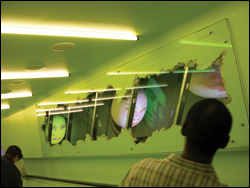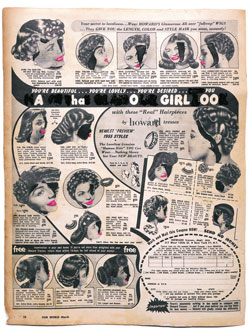Since last month’s opening, the new Central Library’s architecture—with its sweeping angles, translucent planes, and latticed facade that evokes a streamlined beehive—has gotten the most attention. Next has come its innovative functional design. But the three major artworks designed into the building are worthy of note, too.
The library’s art planners, Rick Lowe and Jessica Cusack, both artists themselves, knew what they didn’t want: art that “aestheticized” or decorated the building. Rather, they sought conceptual art that addressed the question “What are libraries for?” To find it, they undertook a national search, eventually selecting three internationally known artists: Ann Hamilton, Tony Oursler, and Gary Hill.
These three are the kind of heavy hitters who get MacArthur Foundation “genius grants” (Hamilton and Hill), represent the United States in the 1999 Venice Biennale (Hamilton), and have solo shows at the Whitney Museum of American Art (Oursler). Their previous work and their reputations as smart, conceptual, philosophical artists convinced Lowe and Cusack that they were the right candidates. Each was charged with creating a permanent, site-integrated installation that commented on the nature and purpose of information—art that considered the physical space of the library as well as its abstract purposes and practical functions.
Oursler’s zanily poetic video installation, Commu, is embedded in the wall alongside the escalator connecting floors three and five. To create the piece, Oursler removed a long expanse of drywall with a crowbar. Irregularly torn drywall frames the installation’s series of murmuring projected heads, lips, eyes, and a floating ear.
Speaking at the Seattle Art Museum on the library’s opening day, Oursler—graying yet boyish, wearing a sport coat, tennis shoes, and bright orange socks—described his installation as “a contemplation on the transmission of information.” He explained that Commu was in part inspired by telephone, the childhood game in which a whispered message is passed from person to person (mouth to ear) around a circle. Usually, by the time the message makes its way around the circle, it has changed dramatically.
I’d say Commu succeeds in provoking contemplation, but of a rather neurotic, angst-filled variety. His video projections of babbling heads, blotchy lips that seem to berate and confide, bloodshot roving eyes, and a phantom blue-gray ear seem to communicate the loneliest longings and obsessions stowed deep in our psyches. Though the viewer’s contact with Commu is a fleeting 15- second escalator ride, it is a potent work, exposing raw emotion within the intimate “innards” of the library walls yet frustrating true contact.
Anne Hamilton’s installation, LEW Floor (named for the Literacy, ESL, and World Languages section of the library where it lies), on the other hand, frustrates the intellect in order to draw attention to different ways of knowing and experiencing the world. The installation is an elegant, expansive maple floor composed of boards into which are routed the opening lines of 556 books in 11 different languages. However, the lettering is all backward, as if seen in a mirror.
This tactile piece mimics the raised lettering used in traditional typesetting and printing, but it also—like much of Hamilton’s work—encourages what she calls “somatic intelligence,” or knowledge that enters the body directly through the senses rather than via the mind. Appearing at first as a floor of Babel that stymies attempts to read it, LEW Floor ultimately invites us to experience the letters through our feet.
Astronomy by Day (and other oxymorons), Gary Hill’s vast, two-screen video projection of hundreds of faintly drawn linear objects, plays in an endless loop on the east wall of the library’s atrium. His menagerie of images, each drawn as a skeletal simulacrum of recognizable items such as hammers, zebras, and chairs, rolls forward like a story unfolding. The diagrammatic outlines seem to reflect the library’s architectural shapes and strata, while the drawings’ ghostliness alludes to the dual nature of books as material objects that express immaterial ideas.
Of course, given that few people visit a library with the intention of viewing art, will library patrons notice and respond to these installations? Fortunately, each is so well conceived and designed that it works as background to the library’s main purpose, yet—like a book on a shelf—yields depth and content when actively explored.






